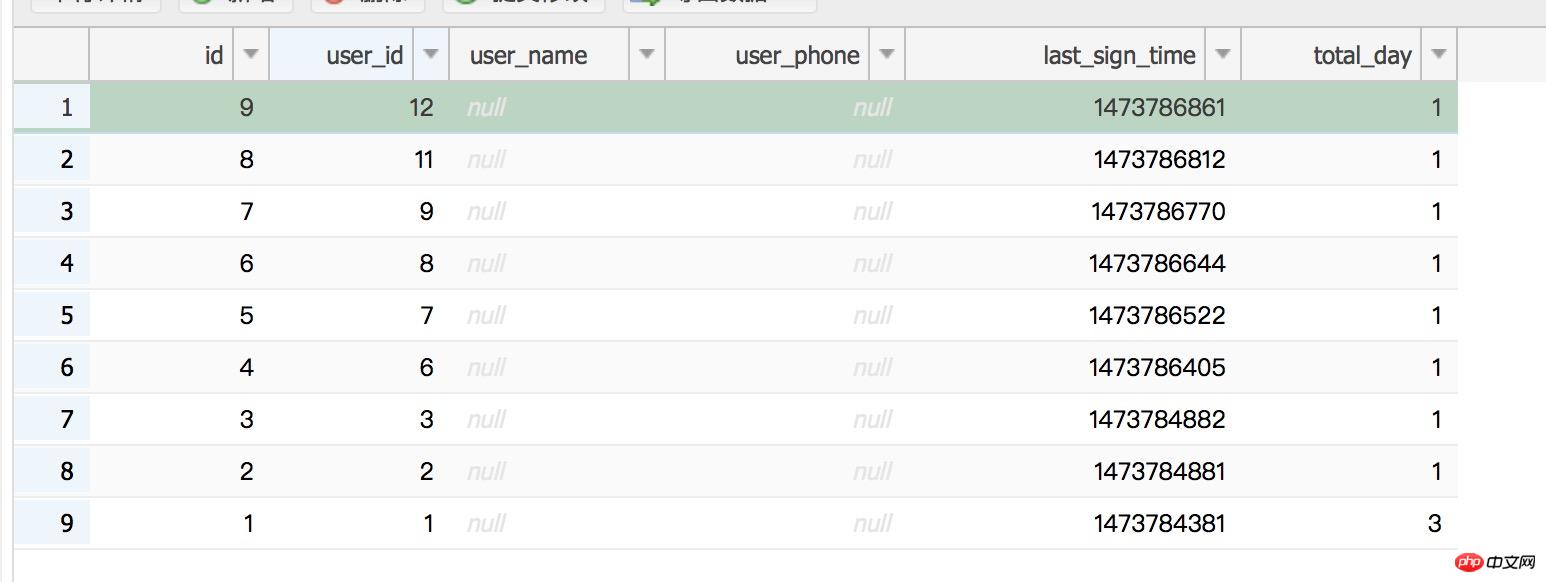
First of all, I built two tables in the database, one is the user's points table, and the other is the check-in status table, which is used to record the user's points and first arrival status


In the user sign-in status table, we have a field, last_sign_time, which is the last sign-in time. Each time you can sign in, compare this time with the current time. If the difference is 0 days, it means you have signed in today (this sign-in can only be signed in once in 24 hours, that is, the difference between the two sign-ins must be more than 24 hours). If it is equal to one day, you can sign in today, if it is 2 days or more, it means you missed the sign-in .
Through the judgment of the timestamp, the status table is updated in a timely manner, and when the sign-in is possible, the user points table is operated, that is, the user points are updated.
<?php
$user_id=@$_REQUEST['user_id'];
//功能:计算两个时间戳之间相差的日时分秒
//$begin_time 开始时间戳
//$end_time 结束时间戳
function timediff($begin_time,$end_time)
{
if($begin_time < $end_time){
$starttime = $begin_time;
$endtime = $end_time;
}else{
$starttime = $end_time;
$endtime = $begin_time;
}
//计算天数
$timediff = $endtime-$starttime;
$days = intval($timediff/86400);
//计算小时数
$remain = $timediff%86400;
$hours = intval($remain/3600);
//计算分钟数
$remain = $remain%3600;
$mins = intval($remain/60);
//计算秒数
$secs = $remain%60;
$res = array("day" => $days,"hour" => $hours,"min" => $mins,"sec" => $secs);
return $res;
}
function upuserscore($current_total_day){
$user_id=@$_REQUEST['user_id'];
//读取数据库配置信息的ini文件
$ary=parse_ini_file('db.ini');
$db_login_name=base64_decode($ary['db_login_name']);
$db_login_password=base64_decode($ary['db_login_password']);
$db_host=base64_decode($ary['db_host']);
$db_name=base64_decode($ary['db_name']);
//链接数据库
$scorelink=mysqli_connect($db_host,$db_login_name,$db_login_password);
mysqli_select_db($scorelink,$db_name); //选择数据库
//检查积分表里是否有该用户 有的话则更新数据 没有的话则插入数据
$scoreq = "SELECT * FROM user_score WHERE user_id=$user_id"; //SQL插入语句
mysqli_query($scorelink,"SET NAMES utf8");
$rs = mysqli_query($scorelink,$scoreq); //获取数据集
if(!$rs){
exit(json_encode(array('status'=>"success",'code'=>"1",'error'=>mysqli_error($scorelink))));
}
if(mysqli_num_rows($rs)){//该用户有数据 则更新其积分信息
$total_score="";
while($row = mysqli_fetch_row($rs)) {
$total_score=$row[4];
}
$scoreusdateq = "UPDATE user_score SET user_total_score ='98' WHERE user_id=$user_id;"; //更新
mysqli_query($scorelink,"SET NAMES utf8");
$ustaters = mysqli_query($scorelink,$scoreusdateq); //获取数据集
if($ustaters ==1){
exit(json_encode(array('status'=>"success",'code'=>"100")));
mysqli_close($scorelink);//关闭连接
exit();
}else{
exit(json_encode(array('status'=>"success",'code'=>"1")));
mysqli_close($scorelink);//关闭连接
exit();
}
}else{//没有该用户数据 则插入其积分信息
$scoreinsertq = "insert into user_score (user_id,user_total_score)values($user_id,10)"; //SQL插入语句
mysqli_query($scorelink,"SET NAMES utf8");
$rs = mysqli_query($scorelink,$scoreinsertq); //获取数据集
if(!$rs){
exit(json_encode(array('status'=>"success",'code'=>"1",'error'=>mysqli_error($scorelink))));
}
if(strpos($q,"SELECT") === false){
exit(json_encode(array('status'=>"success",'code'=>"100")));
}
mysqli_close($scorelink);//关闭连接
}
}
//读取数据库配置信息的ini文件
$ary=parse_ini_file('db.ini');
$db_login_name=base64_decode($ary['db_login_name']);
$db_login_password=base64_decode($ary['db_login_password']);
$db_host=base64_decode($ary['db_host']);
$db_name=base64_decode($ary['db_name']);
//链接数据库
$link=mysqli_connect($db_host,$db_login_name,$db_login_password);
mysqli_select_db($link,$db_name); //选择数据库
//检查签到表里是否有该用户 有的话则更新数据 没有的话则插入数据
$q = "SELECT * FROM user_signin WHERE user_id=$user_id"; //SQL插入语句
mysqli_query($link,"SET NAMES utf8");
$rs = mysqli_query($link,$q); //获取数据集
if(!$rs){
exit(json_encode(array('status'=>"success",'code'=>"1",'error'=>mysqli_error($link))));
}
if(mysqli_num_rows($rs)){//该用户有数据 则更新其签到信息
$last_time="";
$total_day="";
while($row = mysqli_fetch_row($rs)) {
$last_time=$row[4]."<br/>";
$total_day=$row[5];
}
//根据上次签到时间和这次签到时间作比较判断有没有漏签和今日是否已签到
$current_total_day=intval($total_day)+1;
$current_day=time();
$ary = timediff($last_time,$current_day);
if($ary[day]==0){//今天已签到
exit(json_encode(array('status'=>"success",'code'=>"5")));
mysqli_close($link);//关闭连接
exit();
}else if($ary[day]==1){//没有漏签
$usdateq = "UPDATE user_signin SET last_sign_time='$current_day', total_day='$current_total_day' WHERE user_id=$user_id;"; //更新
mysqli_query($link,"SET NAMES utf8");
$ustaters = mysqli_query($link,$usdateq); //获取数据集
if($ustaters ==1){
upuserscore($current_total_day);
//exit(json_encode(array('status'=>"success",'code'=>"100")));
mysqli_close($link);//关闭连接
exit();
}else{
exit(json_encode(array('status'=>"success",'code'=>"1")));
mysqli_close($link);//关闭连接
exit();
}
}else{//漏签过
$usdateq = "UPDATE user_signin SET last_sign_time='$current_day', total_day=1 WHERE user_id=$user_id;"; //更新
mysqli_query($link,"SET NAMES utf8");
$ustaters = mysqli_query($link,$usdateq); //获取数据集
if($ustaters ==1){
upuserscore($current_total_day);
//exit(json_encode(array('status'=>"success",'code'=>"100")));
mysqli_close($link);//关闭连接
exit();
}else{
exit(json_encode(array('status'=>"success",'code'=>"1")));
mysqli_close($link);//关闭连接
exit();
}
}
}else{//没有该用户记录则插入
$current_day=time();
$insertq = "insert into user_signin (user_id,last_sign_time,total_day)values($user_id,'$current_day',1)"; //SQL插入语句
mysqli_query($link,"SET NAMES utf8");
$insertrs = mysqli_query($link,$insertq); //获取数据集
if(strpos($insertrs,"SELECT") === false){//出入数据成功
upuserscore('1');
//exit(json_encode(array('status'=>"success",'code'=>"100")));
}
}
mysqli_close($link);//关闭连接
?>The above is the detailed explanation of the graphic code of PHP to implement the check-in function. For more related content, please pay attention to the PHP Chinese website (www.php.cn)!




